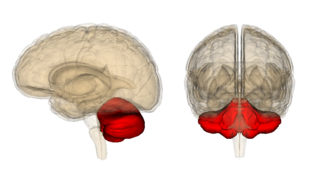The human cerebellum has much more surface area than a monkey’s “little brain.”
Posted Aug 01, 2020

For decades, neuroscientists have known that the human cerebellum (Latin for “little brain”) accounts for only about 10 percent of whole-brain volume, but houses more than 50 percent of the brain’s total neurons. By some estimates (Lent et al. 2011), the human cerebellum holds about 80 percent of the brain’s total neurons.
Based on the disproportionate number of cerebellar neurons, people like Larry Vandervert (2016) have speculated that “the 69 billion neurons of the cerebellum and not the 16 billion neurons of the cerebral cortex do all of the really ‘brilliant,’ heavy lifting work of the brain.” In a May 2016 article, Vandervert elaborates on his hypotheses about the often-underestimated role that the cerebellum may have played in the advancement of human culture:
“In a nutshell, I have argued that during the past tens of thousands of years, the cerebellum has silently (the cerebellum operates below the level of conscious awareness) produced human culture. And not only that, I argue that it is the cerebellum that has allowed humans to constantly advance the key pillars of culture, everything from rearing practices to everyday customs, art, science, music, and technology.”
Now, a new brain mapping study (Sereno et al., 2020) of the cerebellum led by researchers from San Diego State University adds more credence to Vandervert’s hypothesis. In addition to the cerebellum holding almost 80 percent of the brain’s total neurons, new state-of-the-art neuroimaging by SDSU’s Martin Sereno and colleagues from Canada, the UK, and the Netherlands shows that the human cerebellum has nearly 80 percent of the surface area of the cerebral cortex. These findings were published on July 28 in the Proceedings of the National Academy of Sciences.
If a picture is worth a thousand words, this 45-second YouTube video speaks volumes and elucidates the significance of this study with breathtaking 3-D imagery.
“The cerebellum has long been recognized as a partner of the cerebral cortex, and both have expanded greatly in human evolution. The thin cerebellar cortex is even more tightly folded than the cerebral cortex,” the authors explain in the paper’s abstract.
By doing a side-by-side comparison of the human cerebellum and the macaque monkey cerebellum using an ultra-high-field MRI scanner, the SDSU researchers discovered that the tightly packed folds in the human cerebellum have a surface area equal to about 80 percent of our cerebral cortex’s surface area. However, the macaque monkey’s cerebellum is much smaller; its “little brain” is only about 30 percent of its cerebral cortex’s surface area.

“The fact that [our cerebellum] has such a large surface area speaks to the evolution of distinctively human behaviors and cognition. It has expanded so much that the folding patterns are very complex,” Martin Sereno said in a July 31 news release. Sereno is a cognitive neuroscientist, professor of neuropsychology, and director of the SDSU MRI Imaging Center.
From an evolutionary perspective, the explosive growth of the human cerebellum’s surface area in comparison to the relatively static surface area of our primate cousins’ cerebellum size suggests that having a large “little brain” may be tied to some distinctively human abilities such as language, advanced tool-making, and complex sociality.
The authors also speculate that “parts of the cerebellum may have been extended in humans to help coordinate fictive ‘conceptual movements,’ such as rapidly mentally rearranging a movement plan—or, in the fullness of time, perhaps even a mathematical equation.”
“Until now, the cerebellum was thought to be involved mainly in basic functions like movement, but its expansion over time and its new inputs from cortical areas involved in cognition suggest that it can also process advanced concepts like mathematical equations,” Sereno said in the news release.
“Now that we have the first high-resolution base map of the human cerebellum, there are many possibilities for researchers to start filling in what is certain to be a complex quilt of inputs, from many different parts of the cerebral cortex in more detail than ever before,” Sereno added. “Mapping the cerebellum will be an interesting new frontier for the next decade.” (See “Why Mapping Cerebellum–Prefrontal Cortex Circuitry Matters“)
References
Martin I. Sereno, Jörn Diedrichsen, Mohamed Tachrount, Guilherme Testa-Silva, Helen d’Arceuil, Chris De Zeeuw. “The Human Cerebellum Has Almost 80% of the Surface Area of the Neocortex.” Proceedings of the National Academy of Sciences (First published: July 28, 2020) DOI: 10.1073/pnas.2002896117
Larry Vandervert “The Prominent Role of the Cerebellum in the Learning, Origin and Advancement of Culture.” Cerebellum & Ataxias (First published: May 05, 2016) DOI: 10.1186/s40673-016-0049-z

